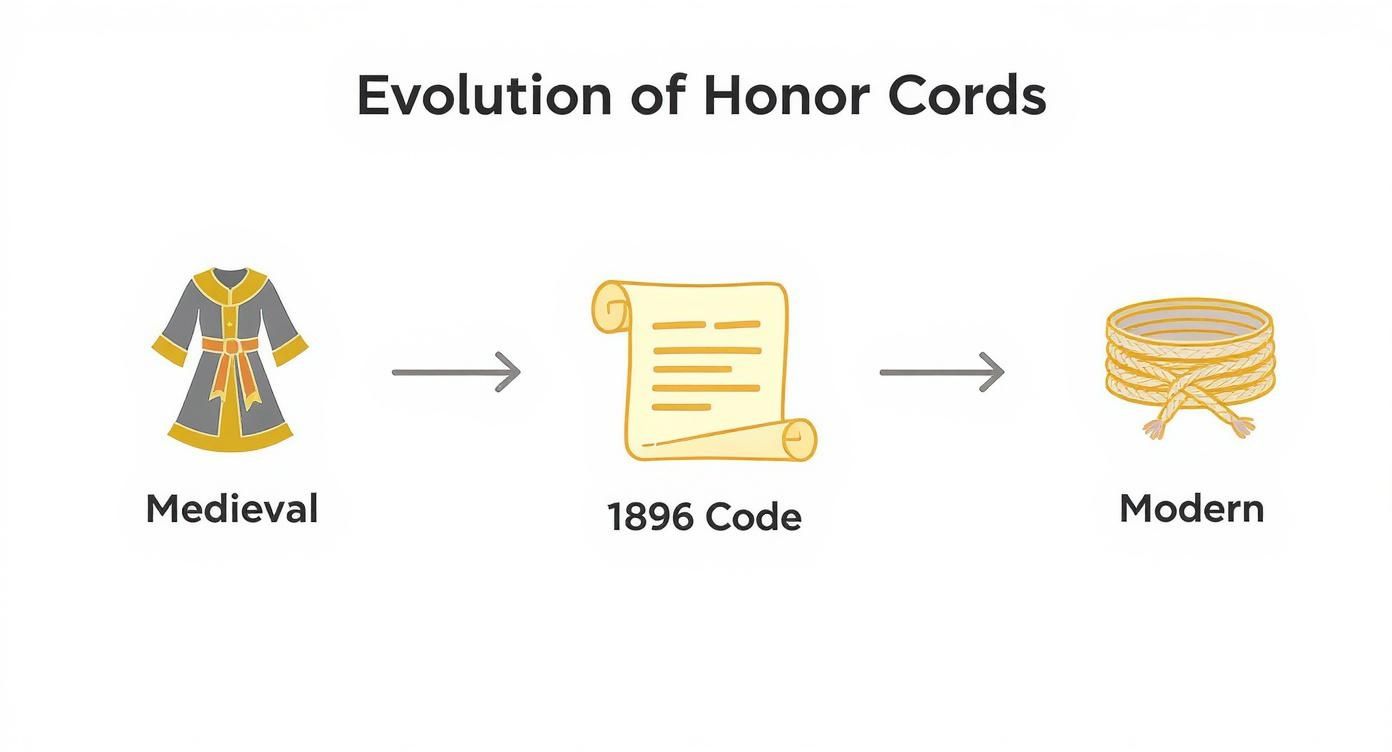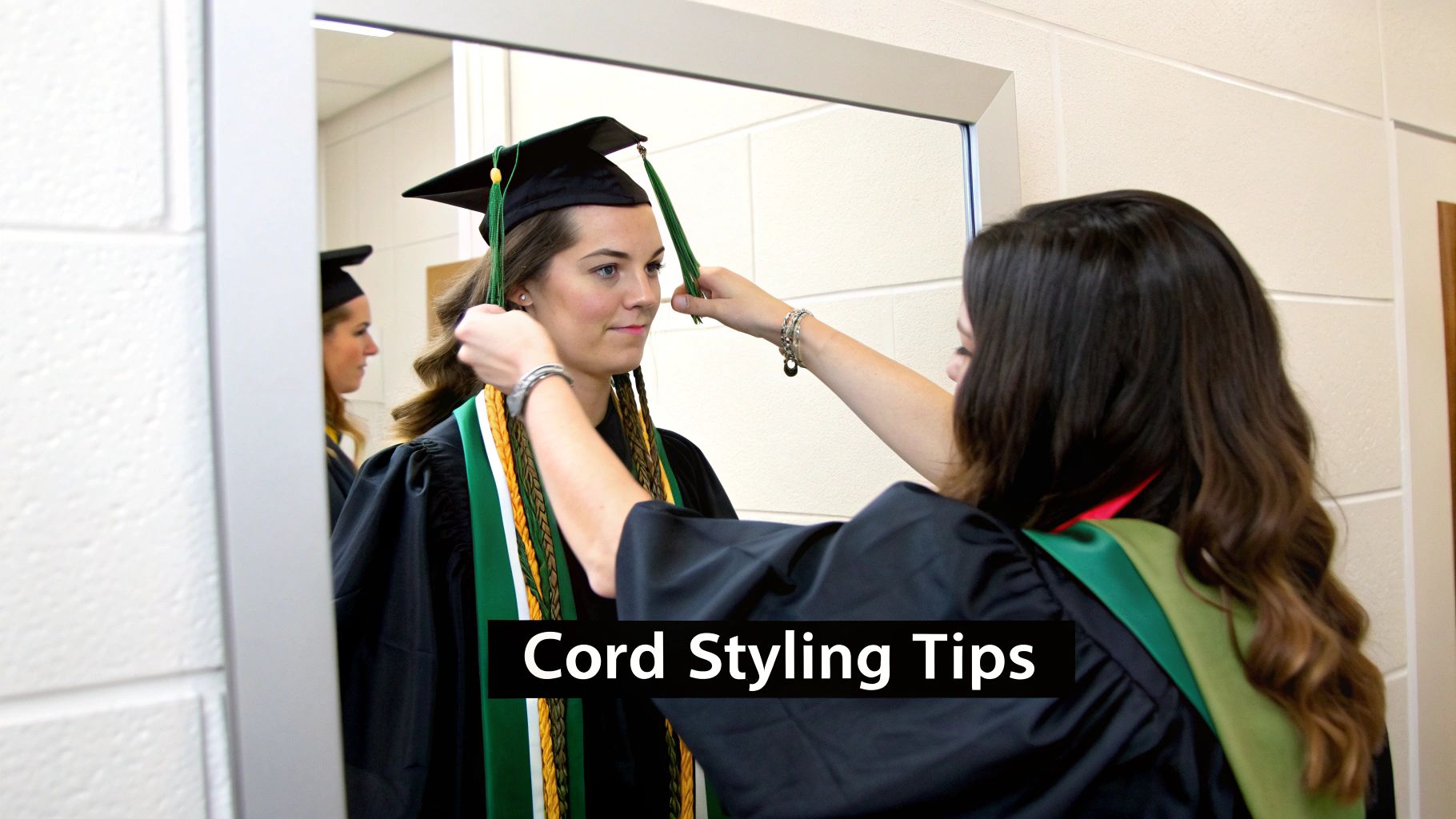Graduation honor cord colors often feel like a private language worn on your gown—a subtle nod to years of hard work and dedication. Each shade carries its own story, from gold celebrating top-tier academics to red shining a light on humanities achievements. Pair them with coordinating graduation stoles or sashes to complete your regalia. Explore our Graduation Stoles Collection for matching sashes and stoles.
Meaning Behind Common Cord Colors

Think of honor cords as badges you earn over time. They let everyone know if you’ve joined an elite society, hit a certain GPA milestone, or mastered a particular discipline.
Imagine a stage play: your cords are the spotlights that highlight exactly what you brought to the performance. Just as lighting designers use color to set the mood, universities use cord hues to convey achievement.
“Honor cords speak without words—each color captures a slice of scholarly achievement.”
Key Points To Remember
- Cum Laude, Magna Cum Laude, and Summa Cum Laude often get you a cord in shades of gold or white.
- Discipline-specific colors tie directly to fields—blue for education, green for science, royal blue for leadership.
- Braided or multi-colored cords usually mean you’ve earned more than one honor or belong to multiple societies.
Below is a quick-reference table that pairs five of the most widespread cord colors with their typical symbolism.
Common Honor Cord Colors And Meanings
| Cord Color | General Meaning |
|---|---|
| Gold | High academic achievement |
| Red | Humanities and passion |
| Blue | Education and loyalty |
| Green | Sciences and growth |
| Purple | Creativity and leadership |
Of course, some schools tweak these associations or add new color combinations. Always check your department’s commencement guide before placing an order.
For instance, a biology major might sport a green cord for science alongside a gold cord for academic honors. And if you’re a member of Phi Beta Kappa, you could see yourself wearing a blue-and-gold cord combination.
To explore each shade in detail—and discover how stoles pair with cords—dive into our full guide on graduation honor cords and stoles.
Quick Key Insights
Patterns in cord assignments tend to follow a loose, time-honored system:
- Gold cords celebrate GPA-based honors the way medals honor athletic achievement.
- Discipline-based colors trace back to 19th-century academic dress codes.
- Unique cord combinations often mark local societies or specialized campus programs.
“Wearing multiple cords is like layering medals—it tells the full story of a graduate’s journey.”
Since every institution can customize meanings, you’ll want to verify with your registrar or department before finalizing your selection.
Tips For Selecting Your Cord
- Check your school’s official color chart in the commencement guide.
- Confirm whether dual honors require a braided design or two separate cords.
- Coordinate with classmates for a uniform look—especially in graduation photos.
Following these steps ensures your cords reflect your achievements accurately and look great in every snapshot.
Evolution Of Honor Cords In Academic Regalia
Way back in medieval Europe, honor cords started life as practical twists of rope that held scholars’ robes together. Picture cloistered monks and early academics knotting heavy drapery—what began as a simple solution soon took on a subtle elegance.
As universities took shape, these cords morphed into tiny status symbols—much like military ribbons that signal valor and service.
- Medieval Practice: Knotted cords fastened gowns and hinted at the wearer’s order.
- Military Comparison: Ribboned medals inspired early cord designs.
- Scholarly Badge: Cords came to denote guild membership and academic rank.
Then came a turning point in 1896, when American colleges agreed on the Intercollegiate Code for academic dress. That agreement standardized caps, gowns—and yes, honor cords—laying the groundwork for ceremonies we still recognize today. For a deeper dive into this milestone, check out the UCCS Commencement Heritage.
Medieval To Modern Timeline
Over the 20th century, color became the next frontier. Schools began assigning gold cords to their top scholars, echoing the luster of crown jewels. Before long, every shade from crimson to teal carried a meaning.
| Era | Purpose | Color Role |
|---|---|---|
| Medieval | Fasten robes, show affiliation | Functional & symbolic |
| 1896 Code | Standardize academic attire | Foundation for color usage |
| Modern | Represent fields and honors | Diverse hues for every merit |
“Cords became badges of achievement much like ribbons on a sash,” recalls one regalia historian.
Freedom In Color Selection
Fast forward to today and you’ll spot over a dozen different cords at a single graduation. Gold still shouts “highest honors,” but you might pair it with turquoise for psychology or maroon for journalism.
Whether you prefer a single strand or a double-braided look, explore our Graduation Honor Cords Collection to match your achievements with the perfect palette.
Customizing Regalia
Many schools now welcome custom cords for clubs, cultural groups, and special awards. This brings personal milestones center stage.
- Dual braids to signify joint majors or dual honors
- Metallic threads for distinguished prizes
- Seasonal colors tied to school spirit and traditions
By weaving together a variety of shades and textures, each graduate tells a one-of-a-kind story of success.
Stoles.com offers matching stoles to complement your custom cords. Mix textures and colors for depth and cohesion on your big day.
Symbolism Of Common Cord Colors
Red cords stand out as a symbol of passion and creativity. They feel like the bold strokes of an artist’s brush, celebrating storytelling and expressive spirit.
Blue represents education and loyalty, evoking the steady guidance of a dedicated teacher. Graduates wearing blue often highlight a commitment to learning and trust.
- Gold cords shine with academic excellence, much like crown jewels catching the light.
- Green cords capture the idea of growth, recalling a seedling reaching toward the sun.
- Purple cords speak to ambition and leadership, a nod to the regal robes of history.
"Like artists choose paint, graduates select cords to depict their academic masterpiece."
When you layer more colors, the ceremony transforms into a painter’s workshop—each cord a deliberate brushstroke. Of course, meanings shift from one institution to another.
The full palette of cords reflects each discipline’s unique character. Across major American universities, honor cords now span 15 distinct colors. Learn more about these findings on GraduationSource.com.
The infographic below traces the journey from medieval academic robes to the vibrant cords of today.
This concept map shows how early standardization paved the way for today’s colorful ceremony accents.
Symbolism In Different Fields
In the humanities, red often links back to scholars in literature and philosophy, channeling courage through each thread. Many institutions reserve it for English, history, and language arts graduates.
Degrees in education frequently feature blue, a color of stability and trust, while green suits sciences, echoing experiments and discoveries. Biology and environmental studies majors especially gravitate toward green cords.
Learn more about field-specific cord choices in our article on color cords for graduation meaning.
For a deeper dive into how hues shape our emotions, explore general color schemes and their emotional impact.
When you pick your cords, imagine them as a curated palette telling your unique academic story. These colors speak volumes when words alone can’t.
Celebrate accomplishments.
Institutional Differences In Cord Color Assignments
At graduation, the color of your honor cord tells a story—but that story changes from campus to campus. Each university builds its own palette, so red might celebrate the humanities at one school and salute an engineering honor society at another.
Think of these color rules like regional accents in a shared language. A crimson cord at University A can signify dedication to the arts, while the very same hue at University B points straight to technical achievement.
- Single cords denote a single honor, such as cum laude recognition.
- Double cords or braids indicate dual achievements like society membership and departmental honors.
- Mixed hues can represent joint majors or cross-disciplinary awards.
Understanding Single And Braided Cords
Many institutions stack cords much like military stripes, each layer adding visual weight to your resume of accomplishments. Braided cords, in particular, signal combined honors—picture your achievements woven together in a tight, meaningful pattern.
Layering cords works like ribbons on a medal rack; each strand adds to your academic story.
Some schools reserve single strands for department awards and double braids for campuswide honors. These traditions can even shift from one year to the next, so doing your homework pays off.
Example Multi-Cord Honor System
Below is a model comparison that illustrates how cord quantities often align with academic honors:
Example Multi-Cord Honor System
| Number Of Cords | Honor Level | Typical GPA Range |
|---|---|---|
| 1 | Cum Laude | 3.50 – 3.69 |
| 2 | Magna Cum Laude | 3.70 – 3.89 |
| 3 | Summa Cum Laude | 3.90 – 4.00 |
This tiered setup offers a quick visual shorthand so faculty, family, and peers can instantly read your GPA milestone.
Tiered Academic Honors
Cum laude, magna cum laude, and summa cum laude each translate into distinct cord configurations. Some schools change color, others tweak braid complexity or even weave in metallic threads to set top graduates apart.
Over the decades, these hierarchies have grown more nuanced.
Discover more about these distinctions on Wikipedia
Each cord or braid tells a chapter in your academic journey.
Still, no two universities match these thresholds exactly. Always peek at your registrar’s site or department handbook before you buy.
Steps To Confirm Cord Assignments:
- Review your school’s official commencement guide for color codes.
- Confirm GPA cutoffs for your desired cum laude tier.
- Browse the Graduation Honor Cords Collection for approved shades.
By cross-checking these details, you’ll be sure to wear the right cord—and tell your story accurately.
Consult Institutional Policy
Every campus publishes its color chart differently. You might find it on the registrar’s website, buried in a departmental handbook, or listed on a bookstore’s regalia page.
- Registrar’s sites often house commencement resources.
- College advising pages may list discipline-specific regalia rules.
- Campus bookstores and vendors can confirm approved cord styles.
Locating the official color guide guarantees you won’t order the wrong cords—and that you’ll look sharp on your big day.
For a reliable selection of premium-quality cords, check out our Honor Cords collection.
Choosing The Right Cord Color
Picking your honor cord is a bit like adding the final brushstroke to a painting. It needs to reflect both your achievements and your school’s traditions.
Before anything else, pull up your institution’s official color chart. Chat with your department advisor and skim through any honor society rulebook. Getting this step right now will save you a scramble on graduation morning.
- Contact your academic advisor by email or in person
- Download the registrar’s commencement guide online
- Verify discipline-specific colors with your department office
Confirm Official Requirements
Start by comparing your school’s published color codes. A slight shade difference or braid style swap can shift a cord’s entire meaning.
“Order early to match your achievements with the right color and style,” advises one commencement planner.
Once you’re certain about the official palette, you can let your creativity loose.
Explore Custom Cord Options
Standard colors are great, but custom cords let you tell a fuller story—club memberships, dual honors or special awards all in one design.
- Review approved color palettes on your school’s site
- Select braid styles or metallic threads for dual honors
- Submit any custom requests at least two months before graduation
Common Selection Pitfalls
| Mistake | How to Avoid |
|---|---|
| Ordering last minute | Set alarms for key deadlines |
| Misreading color guidelines | Highlight exact hex codes or fabric swatches |
| Skipping advisor consultation | Schedule a quick department meeting |
Use Practical Decision Tools
A simple decision tree keeps you on track:
- Did you earn departmental honors?
- Yes: Use your department color
- No: Move on
- Are you an honor society member?
- Yes: Add the matching society cord
- No: Stick with standard achievement cords
- Want a custom statement?
- Yes: Browse customization options
- No: Choose from our pre-approved collection
Best Practices For Final Selection
- Double-check shipping dates so your cord arrives before regalia pickup
- Compare cord swatches under natural light to match your gown
- Coordinate with classmates for a cohesive graduation look
- Tuck a spare cord into your ceremony essentials kit
These small steps ensure your cord shows up on time and photographs perfectly.
“Your cord color is the finishing touch that ties your academic story together.”
Ready to pick your perfect hue? Use our color guide and order with plenty of time for personalization.
Finally, browse our Graduation Honor Cords Collection to see high-quality options in every approved shade. Our curated selection helps you nail your ceremony look with confidence and style.
Styling Honor Cords With Stoles And Sashes

Think of layering your honor cords and stoles as crafting a gourmet sandwich: each element should stand out without adding bulk. A little planning up front ensures every hue and texture gets its moment in the spotlight.
Start by laying your stole flat and draping the sash evenly over your shoulders. Use simple knots at the collar to anchor the cords, then let them fall in graceful, equal streams down each side.
Cord Drape Essentials
- Align all cords so the ends rest around mid-chest for a balanced look.
- Pick cords and stoles in complementary shades to create visual harmony.
- Clip cords at the shoulder seams to prevent slipping beneath your gown.
A quick sketch or mock-up can save you from tangles once you’re in your gown.
“Neat layering highlights each honor without overwhelming your gown,” advises a commencement stylist.
Pairing Colors With Confidence
Color matching is part art, part intuition. Warm combos—think maroon and gold—make striking photos, while cool pairings like teal and silver convey calm assurance.
Don’t be afraid to experiment. A vivid contrast can pop off camera, whereas a tonal match keeps the ensemble understated.
Numbered Steps For Clean Styling
- Spread your stole flat over a chair or table.
- Center the cords on the stole and tie a neat knot at the collar.
- Fasten a small clip behind the gown collar to lock everything in place.
This routine locks in your look and keeps lines straight as you move across the stage.
When you’re experimenting with these wraps, remember that adding a little stitchwork can elevate the look. That’s why diving into personalization methods such as understanding embroidery techniques can be valuable. Embroidery adds polished details to stoles that echo your cord colors.
Sarah, a chemistry major, tied 3 little knots and walked away with best-dressed honors at her ceremony. Secure clips discreetly for a tidy, stage-ready finish.
For a step-by-step walking tour of styles and layouts, see our tutorial on how to wear honor cords for graduation. You’ll find expert tips on cord spacing, color patterns, and knot types.
Tips For Photo-Ready Cords
- Stand tall and give your cords one last gentle pull before stepping up.
- Smooth the stole over your shoulders to avoid wrinkles in pictures.
- Ask a friend to check your cord symmetry—two seconds can save a lifetime of photos.
FAQ On Graduation Honor Cord Color Meaning
Finding your school’s official cord lineup doesn’t have to feel like a treasure hunt. Often, your registrar’s website or the graduation handbook hosts a full-color chart.
If you dig a little deeper, many universities publish a PDF map detailing cord shades by department. Still not sure? Shoot a quick message to your department advisor—they’ll have the latest updates.
- How Do I Find My School’s Cord Guide? Check the registrar’s site or touch base with your academic advisor for the current chart.
- Can I Wear Multiple Cords at Once? Absolutely. It’s common to layer single strands or braided cords to represent dual honors.
- What Do Braided Cords Represent? They typically signify combined achievements—think honor society plus departmental honors.
- Are Cord Colors Standardized Nationwide? No. Every institution crafts its own palette, so always verify your school’s specific guidelines.
These pointers should give you a clear roadmap for decoding cord colors.
Confirm Official Color Rules
Locking in the right shade starts early. Most schools publish clear PDF guides complete with hex codes or fabric swatches.
“Mistiming your cord order can force you to switch shades at the eleventh hour.”
Aim to place your order at least two months before graduation. While you’re planning, browse our Graduation Honor Cords Collection to explore premium options.
Don’t forget to check shipping lead times and sync up with classmates for a unified look.
Ordering Official Cords
Many universities name an approved vendor list to keep cord colors consistent. Visit those vendors’ websites and compare swatches or hex codes to your school’s guide.
For example, our store offers a range of cords in exact department colors, various braid styles, and even metallic accents—so you get the perfect match every time.
Multiple Cord Styling
Think of your cords like ribbons on a medal rack—the order matters.
- Lay each strand flat and align the ends at mid-chest.
- Tie a small knot right at the collar seam so everything drapes evenly.
- Secure the cords under your gown with cord clips or tiny safety pins.
This technique keeps cords looking crisp through every handshake, photo, and gust of wind.
Ready to find the perfect cords? Visit Stoles.com® at https://www.stoles.com


